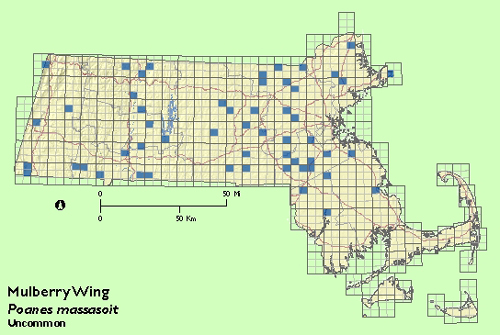Butterfly Atlas
Find a Butterfly
Mulberry Wing
Poanes massasoit
Named
Scudder, 1864

Identification
Wingspan: 1 to 1 and 1/8". This stubby winged, dark skipper is readily identified by the diagnostic bold airplane-shaped markings on the reddish-brown (mulberry-colored) hindwing below. Maynard‘s (1886) common name, "yellow cross skipper," well describes the color and pattern of these striking marks. Above, the Mulberry Wing is dark brown to black with variable light spotting with the basal portion of the forewing being noticably lighter. A rare form, suffusa or ssp. chermocki, in which the underwing pattern is absent (replaced by a suffusion of rusty brown scales) has also been recorded (Scott, 1986). Such specimens were not, however, located during the Atlas period and may occur only south of Massachusetts.
Distribution
The Mulberry Wing occurs primarily in two disjunct areas: one covering parts of southern Ontario, Minnesota, and Iowa, eastward in a broad swath around Lake Michigan and another in eastern New York and southern New England south through eastern Pennsylvania and along the Atlantic seaboard into Maryland (Opler and Krizek‘s, 1984). In New England, the Mulberry Wing is restricted to southern New Hampshire and Vermont and southward through Massachusetts, Rhode Island, and Connecticut.
Status in Massachusetts
Uncommon and local in freshwater wetlands throughout most of the state; apparently absent from much of southeastern Massachusetts. Sometimes found in substantial numbers as in 1991 when observers throughout the northeast reported above average numbers (pers. comm. J. Glassberg, also NABA counts). Maximum: 32 at Easton (Bristol Co.), August 6 1992.

Flight Period in Massachusetts
One flight: 2nd week of July through early August. Extreme dates during the Atlas period: 4 July 1994, Milford (Worcester Co.), R. Hildreth and 10 August 1986, Sharon (Norfolk Co.), B. Cassie.
Larval Food Plants
The only documented hostplant is Tussock Sedge (Carex stricta); possibly other sedges or grasses.
Adult Food sources
Swamp Milkweed, Common Milkweed, Buttonbush, and Narrow-leaved Mountain-Mint were all noted during the atlas period.

Habitat
The Mulberry Wing is largely restricted to freshwater wetlands and may be found in such locales as tussock marshes, river flood plains, swamps, and bogs. Nearby uplands with nectaring sources are occasionally visited.
Life Cycle
EGG: White; oval-shaped. OVIPOSITION: Unrecorded (see, Note). LARVA: Dark green with long yellow hairs. CHRYSALIS: Unrecorded. OVERWINTERING STAGE: Unrecorded.
Notes
Scudder‘s (1889) brief account leaves little doubt that he was personally unfamiliar with this insect in the field. His normally detailed "Life history" section is uncharacteristically sparse and even offers the mistaken information that the Mulberry Wing had two flights. Scudder concluded his account with the plea that " we are totally ignorant of its early stages and need detailed information. . ." A century later, the inquisitive student searching the literature for some of the details Scudder hoped would be forthcoming will be disappointed to find little progress has been made in filling in our understanding of this butterfly.
Account Author
Richard K. Walton



